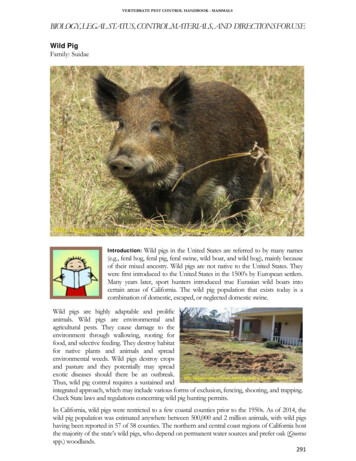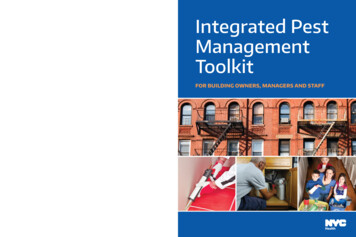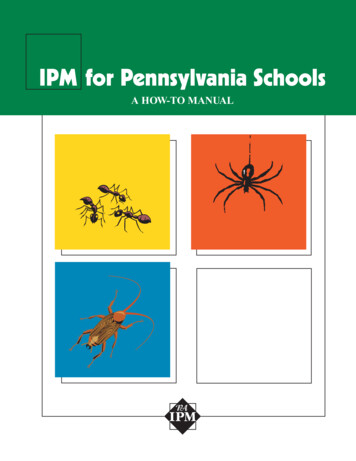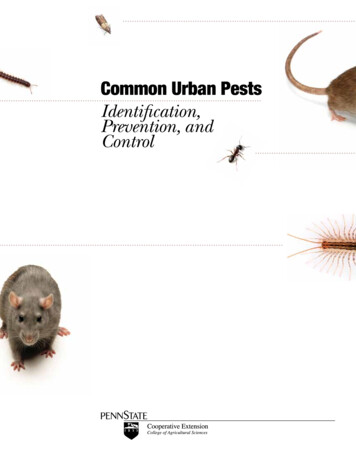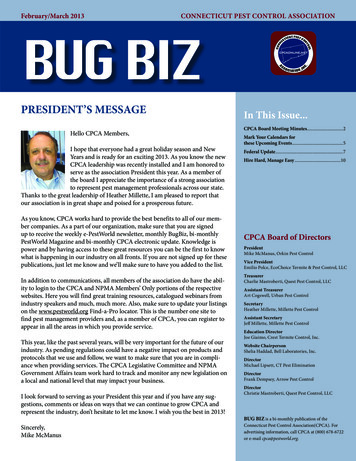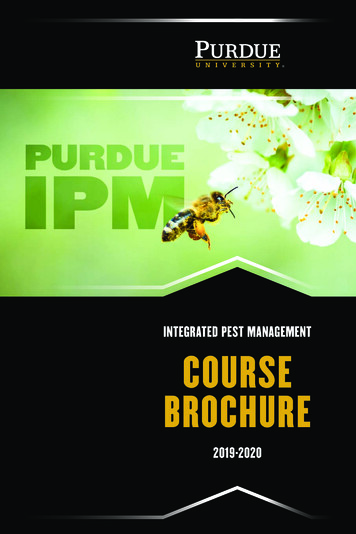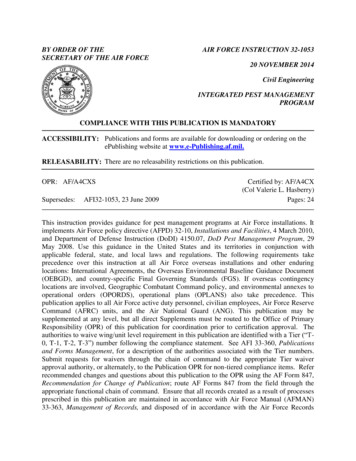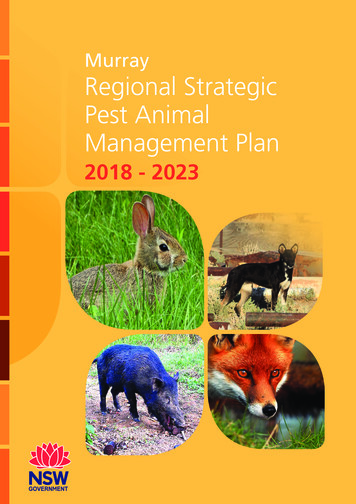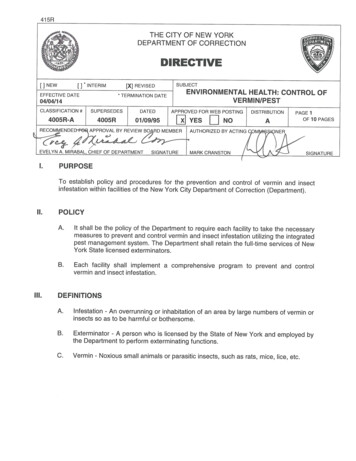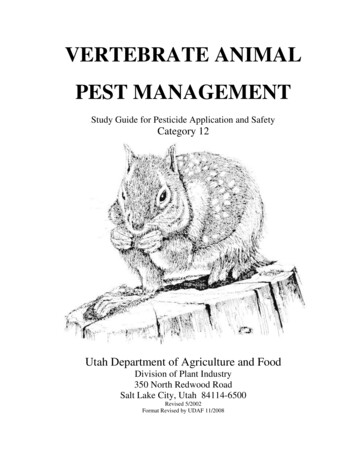
Transcription
VERTEBRATE ANIMALPEST MANAGEMENTStudy Guide for Pesticide Application and SafetyCategory 12Utah Department of Agriculture and FoodDivision of Plant Industry350 North Redwood RoadSalt Lake City, Utah 84114-6500Revised 5/2002Format Revised by UDAF 11/2008
STUDY GUIDE FORVERTEBRATE ANIMALPEST MANAGEMENTThe educational material in this study guide is practical information to prepare you to meet thewritten test requirements. It doesn’t include all the things you need to know about this pest-controlsubject or your pest-control profession. It will, however, help you prepare for your test.Contributors include the Utah Department of Agriculture and Utah State University ExtensionService. This study guide is based on a similar one published by the Colorado Department ofAgriculture. Materials for that guide were prepared by Colorado State University Extension Service.Other contributors include: University Extension Service personnel of California, Illinois, andGeorgia, as well as the materials prepared in the previous draft by Metro-Pest ManagementConsultants, Inc. were utilized freely and with appreciation in preparing this study guide.The information and recommendations contained in this study guide are based on data believed to becorrect. However, no endorsement, guarantee or warranty of any kind, expressed or implied, is madewith respect to the information contained herein.Additional topics that may be covered in your examinations include First Aid, Personal ProtectiveEquipment (PPE), Protecting the Environment, Pesticide Movement, Groundwater, EndangeredSpecies, Application Methods and Equipment, Equipment Calibration, Insecticide Use, Application,Area Measurements, and Weights and Measures. Information on these topics can be found in thefollowing books:1. National Pesticide Applicator Certification Core Manual, Published by the NationalAssociation of StateDepartments of Agriculture Research Foundation.These books can be obtained from the Utah Department of Agriculture or Utah State UniversityExtension Service. Please contact your local Utah Department of Agriculture Compliance Specialistsor Utah State University extension agent.i
iiThe following individuals at Utah State University Extension contributed to the revision of thismanual: F.R. Beard and H.M. Deer.
TABLE OF CONTENTSSUBJECTI.PAGEINTRODUCTION .1II. MANAGEMENT OF MAMMAL PESTS . 3III. MANAGEMENT OF BIRD PESTS . 25IV. MANAGEMENT OF OTHER PESTS . 30VI. PROTECTING GROUNDWATERAND ENDANGERED SPECIES 36VII. CALLIBRATION INFORMATION . 39GLOSSARY OF TERMS 43iii
This page should be blank.iv
INTRODUCTIONTOPICPAGESTUDY GUIDE . 1HABITAT MANIPULATION . 1BEHAVIOR MANIPULATION . 1POPULATION REDUCTION . 2PRECAUTIONARY STATEMENT . 2STUDY GUIDEHABITAT MANIPULATIONThis study guide provides informationspecific to the control of vertebrateanimals in Utah that are common pests.Vertebrate animals include mammals,birds, reptiles, amphibians, and fish. Fishare covered in the Study Guide forAquatic (Surface Water) Pest Control.Domestic or commensal rodents such asrats and mice are covered in the StudyGuide for Structural Pest Control. Thisguide does not discuss the many desirableattributes of animals.Habitat manipulation or modification is aneffective management tool for excludingmany vertebrate pests. Closing smallopenings in buildings can rodent proof orbat proof a structure. Installing orimproving fences can exclude numeroustroublesome species including snakes,skunks, and deer.The classification of an animal as a pest isoften dependent upon its relationship withhumans. Problem animals are oftendifficult to control because of theirproximity to buildings, farmsteads,homes, industrial operations, and othersites frequented by humans. Vertebratepest control methods are generallyclassified under the categories of habitatManipulation, behavior manipulation, orpopulation reduction.BEHAVIOR MANIPULATIONBehavior manipulation uses techniquesand equipment to reduce or eliminatenuisance and/or damage by pests.Repellents, defined as chemical orphysical (mechanical) deter animals bytheir sense of sight, smell, touch, taste,hearing, or a combination of these.Physical repellents include flashing lights,noise producing devices, electricallycharged wires, scarecrows, nets, or othercontrols. Chemical repellents generallyinfluence behavior through taste, smell, ortouch. Chemical repellents include tackyor sticky substances placed on windowledges to discourage tree squirrels orpigeons. Other examples include the1
chemical repellents for pests such as bats,rabbits, canines, and deer.for proper use. Read and follow the labelinstructions.POPULATION REDUCTIONPopulation reduction is achieved by director indirect means.Direct reductioninvolves artificially induced deaths andindirect reduction lowers the populationthrough some agent or mechanism. Directpopulation reduction uses techniques suchas toxic baits, gases, trapping, or shooting.Populations are often reduced indirectlythrough habitat manipulation. Feweranimals will be produced and survive ifthe habitat is restricted or made lessfavorable to the pest species. Fillingcavities in backyard trees will prevent treesquirrels from using them as nest sites.Controlling grubs in a lawn will reducethe food supply for skunks, making theirpresence less likely.When the number of animal pests is smallthe problem can be resolved withoutpesticides. In situations where the pestpopulation is high, pesticides are often theonly economical and practical approach.PRECAUTIONARYSTATEMENTAll pesticides have both benefits andrisks. Benefits can be maximized andrisks minimized by reading and followingthe labeling. Pay close attention to thedirections for use and the precautionarystatements. The information on pesticidelabels contains both instructions andlimitations. Pesticide labels are legaldocuments and it is a violation of bothfederal and state laws to use a pesticideinconsistent with its labeling. Thepesticide applicator is legally responsible2
II. MANAGEMENT OF MAMMAL PESTSTOPICPAGEMAMMAL PESTS . 4BATS . 4PRAIRIE DOG S 5POCKET GOPHERS 7VOLES . 10GROUND SQUIRRELS . 11SKUNKS . 11MUSKRATS . 13RABBITS . 14TREE SQUIRRELS. 15PORCUPINES . 16COYOTES . 18FOXES . 18RACCOONS . 20DEER. 20ELK . 213
MAMMAL PESTSNumerous mammalian species are in conflict with thehuman residents of Utah. The problems frequentlyinvolve vertebrate pests competing with people and/orlivestock by feeding on forage crops such as grasses andalfalfa, feeding on or damaging trees and shrubs, andkilling or harming domestic livestock. Other conflictsoccur when they enter buildings, eat food or feed, andcontaminate the facilities with their droppings.Some mammals also carry diseases that are transmissibleto humans and pets. In addition to mammals covered inthis guide other mammals such as badgers, bobcats,beaver, mink, weasels, marmots, pronghorn, bear,mountain lion, moose, and wild horses occasionally causeproblems in Utah.Utah’s wildlife, identified as big game, small game,furbearers, and nongame is under the authority of theUtah Division of Wildlife Resources. This state agencypublishes annual proclamations and maintains a web site www.wildlife.utah.gov dedicated to the rules andregulations concerning the lawful control, trapping, andkilling of wildlife.Instructions included in the proclamations and on thewebsite state that “A person may not engage in hunting ortrapping protected wildlife or in the sale, trade or barterof protected wildlife or their parts without first havingprocured the necessary licenses, Certificates ofRegistration, permits and tags as provided in the WildlifeResources Code and having at the same time the licenses,Certificates of Registration, permits and tags on his or herperson.”BATSBIOLOGY AND BEHAVIORThe plain-nosed bats and the free-tailed bats are the twofamilies of bats in Utah. The largest is the adult big freetailed bat with a wingspan of 17 inches and a weight ofless than 1 ounce. The smallest, the adult westernpipistrelle, is the size of a hummingbird and weighs 1/10ounce. The fur color of these species is a mixture of tans,browns, rusts, and black, with some white accent.Utah bats live in and use a variety of habitats asroost sites. These roosts may include caves andmines, tree foliage, hollow trees, cracks in rockcliffs, and buildings. Most Utah bat species areyear round residents of the state that hibernateduring the winter. Hibernation is a specialadaptation bats use to survive cold periods wheninsects are not available. In late summer, batsprepare for hibernation by feeding heavily andaccumulating extra body fat. Most bats are ableto store enough fat to last through thehibernation period, which can last six months.In the autumn, bats seek out cool environments,where they are able to lower their bodytemperature, breathing, metabolism, and bloodcirculation to begin hibernation. If repeatedlydisturbed during hibernation, the bats maystarve to death before spring. Because goodhibernation sites are becoming scarce, thousandsof bats of several species may gather in a singlecave or abandoned mine. The average life spanfor a bat is 10 to 20 years. Natural enemies ofbats include hawks, owls, cats, raccoons, snakes,bobcats, ringtails, and weasels.DAMAGEThe damage caused by bats is related theanimal’s feces, called bat guano, and the dangerof rabies transmission. Bat guano has thepotential to produce histoplasmosis, a fungusthat formson moistanimal wastes.Histoplasmosis, when dry, forms a dust that ifbreathed into the lungs can cause flu-likesymptoms in humans. Large concentrations ofbat guano can also irritate the eyes and producea mess.The danger of a bat can bite is not in the wound it inflictsbut rather the potential to transfer a fatal disease. Petsshould receive their rabies shots and these animals shouldnot be handled because a bat will bite like other wildanimals.If a bat bites a person, the bat should be captured withoutdamaging the head, and the local health departmentshould be contacted to have the bat examined for rabies.If the bat is confirmed rabid, the person must undergorabies treatment.4
CONTROL METHODSExclusionThe best long-term solution to problems with bats in theattic is exclusion. Excluding bats should not be triedfrom mid-June through early August, because flightlessyoung may be trapped inside, resulting in offensive odorswhen they die. Bats can be excluded by plugging allholes greater than 3/8 inch with caulking, flashing,screen, fiberglass insulation, or stainless steel wool.Before trying bat-proofing, make sure all bats are out ofthe building. If bats are present, leave a few small holesopen and plug them a few hours after dark, after all batshave left for the evening. If all bats have not left the attic,place a commercial bat-excluder over the hole to allowexit and prevent reentry.RepellentsBats can be encouraged to leave attics by placing 5pounds of naphthalene crystals or flakes per 2,000 cubicfeet in the area. Place these materials in stockings orcloth so they can be removed after the bats leave.Naphthalene should not be used in human living quarters,because prolonged exposure to the vapors may behazardous.All repellents are only temporary ineffectiveness and are a waste of time if not used inconjunction with bat-proofing measures. Bright lightsand drafts created in the attic also encourage bats toleave.LEGAL STATUSUtah law protects all species of bats. It is illegal tointentionally kill bats. Additional protection is extendedto bat species on the federal endangered species list.PRAIRIE DOGSBIOLOGY AND BEHAVIORThree species of prairie dogs are found in Utah.They are the Utah prairie dog, the Gunnisonprairie dog, and the white tailed prairie dog.Prairie dogs are burrowing ground squirrels thatweigh 1-1/2 to 3 pounds and are 14 to 17 incheslong. Their reddish fur, large eyes, short ears,and broad, round head identify prairie dogs.Prairie dogs live in colonies, commonly referred to asprairie dog towns. Small groups, generally composed of1 adult male, 3 adult females and 6 offspring will displayterritorial behavior toward adjacent groups in the town.Prairie dogs live in burrows about 10 yards apart, 3 to 14feet deep and 10 feet to more than 100 feet long. Acrater-like mound 3 to 10 feet across and 1/2 to 1 foothigh at the entrance of the burrow prevents water fromrushing in and serves as a lookout station.A density of 35 Utah prairie dog burrows per acre iscommon. Some burrows have 2 or 3 entrances. Prairiedogs are active only during the day. They do nothibernate, but they will stay below ground for severaldays during cold, cloudy weather.Prairie dogs have 1 litter of 3 to 8 young per year, born inMarch or April. The gestation period is 28 to 34 days.The pups venture above ground at an age of 5 to 6 weeksand disperse in late spring, usually a distance of 2 milesor less.Prairie dogs and their burrows serve as important hostsfor numerous other animals. In Oklahoma, 89 vertebratespecies were associated with prairie dog towns. Prairiedogs are an important food source for predators,including the endangered black-footed ferret, badgers,coyotes, foxes, eagles, prairie falcons, hawks, and owls.Their burrows serve as homes for burrowing owls,cottontail rabbits, rattlesnakes, and other animals.The burrowing activity of prairie dogs decreases soilcompaction, increases water intake, aerates the soil, andpromotes soil formation. Prairie dogs also providerecreation for photographers, hunters, and naturalists.DAMAGEPrairie dogs are hosts for fleas that occasionally carrybubonic plague. Plague is transmitted to humans viafleabites. Early symptoms of plague include swollen andtender lymph nodes, chills, and fever. Early diagnosis5
and treatment are imperative. When walking throughsuspected plague areas, individuals should apply an insectrepellent to socks and pant cuffs and tuck pants insideboots.The effect of prairie dogs on the reduction of availablerangeland forage for livestock is currently unknown.Reduction can be influenced by several factors, includinggeographic location, rainfall, dominant grass species, andduration of prairie dog inhabitation. Recent researchsuggests a wide variety of effects ranging from a 20 to 30percent reduction in available forage to an actual increasein the percent of grass species preferred by livestock.CONTROL METHODSShootingIntensive shooting of small prairie dog colonies willsometimes control their numbers because it disruptsreproductive activities and removes individual animals.BaitsBaits for prairie dog control must be used with cautionbecause poison grain baits can kill a wide variety of birdsand mammals. Poison grain baits for prairie dog controlin Utah are restricted use pesticides that include 2 percentzinc phosphide on oats or a pelleted form of oats. Poisongrain bait is most effective when the prairie dog's mostdesirable food, green grass, has become dry and dormant.Fall baiting generally is most successful, because prairiedogs actively eat grass seeds to build fat reserves for thewinter. Spring baiting generally is less successfulbecause pregnant females often are not above ground,weather conditions are not predictable, and baitacceptance is poor when grass starts turns green.Poison grain baits for prairie dog control are mosteffective during clear, settled weather when temperaturesare moderate. Rain will wash the toxicant from mostbait. Zinc phosphide application is restricted to a periodfrom July 1 through December 31; however, it is mostsuccessful when applied between September andNovember.Prebaiting with untreated oats, preferably steam rolledoats, 2 to 3 days prior to baiting will increase theacceptance of treated bait and result in significantly bettercontrol. Both prebait and bait should be applied by handon the edge of each mound where bare soil and grassinterface. Do not place bait on top of the mound or downthe burrow. The treated bait should be thinly scattered ina 6-inch bait spot, preferably during early morning.Avoid placing treated bait in piles that may endangerlivestock. Apply treated bait only after most of theprebait has been eaten and only to burrows where theuntreated bait was eaten. If most of the prebait is notgone after 1 day, application of both the prebait and baitshould be postponed.The amount of poisoned grain should not exceed 1heaping teaspoon or 4 grams of zinc phosphide bait permound. A typical prairie dog town requires about 1/3pound of zinc phosphide bait per acre. Application ofexcess bait will not improve control but will increase therisk to nontarget animals. Poison grain bait should beapplied only once per season, because survivors of thefirst treatment tend to become bait shy.Zinc phosphide is poisonous to all animals and it shouldbe stored away from humans and pets. Rubber glovesshould be worn to avoid contact with the chemical, andextra care must be taken to avoid breathing zincphosphide dust.When poison grain baits are applied according todirections, they usually result in an 80 to 90 percentreduction in prairie dog numbers. Unsuccessful controlgenerally is associated with the presence of green grass orfailure to prebait.FumigantsFumigants are used when additional control isrequired. Aluminum phosphide tablets and gascartridges are the 2 fumigants used for prairiedog control in Utah. Aluminum phosphidetablets emit a poisonous gas, whereas gascartridges produce a suffocating gas primarilycomposed of carbon monoxide. Fumigants areexpensive, laborious to apply, and hazardous towildlife. They should be used on small acreages,as follow up to poison grain baits, or on largeacreages where grain baits are prohibited.When using a fumigant as follow-up to a baitingprogram, treat only active mounds. This will greatlyreduce the amount of fumigant used. To identify activemounds, shovel the soil or place a dry cow chip over allholes. It is important to begin treatment the next dayafter plugging holes, because one prairie dog willuncover several holes in 3 or 4 days.Due to high soil moisture, fumigants are most effectivewhen used in early spring. Also, young prairie dogs havenot been born or they are still in their original burrows.After fumigants are placed in the burrow, immediatelyplug the opening with moist soil or a plug of the sodplaced grass side down to form an airtight seal. Becareful to not cover or smother the fumigant whenplugging the opening.A wadded newspaper placed in the burrow followingapplication of the aluminum phosphide tablets may deterprairie dogs from digging out before they die. Aluminum6
phosphide appears to provide the best control when soiltemperatures are above 60 degrees F. As a general rule,fumigants will not provide satisfactory control if the soilis dry.The hydrogen phosphide gas (phosphine) produced byaluminum phosphide tablets is toxic to all forms ofanimal life. Exposure through inhalation producessymptoms such as a pressing sensation in the chest,dizziness, nausea, vomiting, and a rapid onset of stupor.Affected persons should be exposed to fresh air andreceive immediate medical attention.Avoid using fumigants in burrows occupied by blackfooted ferrets, burrowing owls, rabbits, and othernontarget wildlife. The white droppings, pellets, andfeathers found around the burrow opening identifyburrows occupied by owls.Four species of pocket gophers are found in Utah. Thefour species are distributed in almost entirely differentareas, possibly because of different ecologicalrequirements or competition. Plains pocket gophers areabundant in sandy and silty soils of the plains, but theyare not abundant in compacted soils.The northern pocket gopher can be found in the deep,sandy soils of the plains and in the shallow gravel ofmountainous areas. It is the most common species inmountain rangelands and forests. The valley pocketgopher is found mainly in soils of warm valleys insouthern Utah.The yellow-faced pocket gopher inhabits a portion of thearea in southeastern Utah where the plains pocket gopheris found. However, the yellow-faced pocket gopher isconfined to drier sites or sites with soils that are lessfavorable for the plains pocket gopher.Extermination of prairie dog populations doesnot guarantee the recovery of productiverangeland. Mounds should be leveled and diskedto speed recovery. To allow the grass and rootsystem to recover, exclude livestock from the dogtown for at least 1 growing season, and reseedthe area with native grasses. Prairie dogs do notthrive in tall grass and management for grassgrowth can discourage reinvasion by prairiedogs.LEGAL STATUSAt the time this publication was printed, the Utah, whitetailed, and Gunnison’s prairie dogs are not protected, butcertain areas of the state are closed to the taking of prairiedogs. The Utah and Mexican prairie dogs are classifiedas threatened or endangered species. Refer to the UtahDivision of Wildlife Resources for current regulationsconcerningthestatusofprairiedogs http://www.endangeredspecie.com/states/ut.htm .POCKET GOPHERSBIOLOGY AND BEHAVIORPocket gophers are burrowing rodents, 7 to 13inches long and weighing 3 to 14 ounces, thatspend most of their lives below ground. They arenamed for the fur lined cheek pouches locatedalong side of the mouth. The pockets are used tocarry food. Gophers have powerfully builtforequarters with large claws on their front feet,a short neck, external ears, small eyes, and lipsthat close behind their large incisors.Pocket gophers attain the highest densities on lighttextured soils with good herbage production. Shallowsoils limit pocket gopher populations because of tunnelcave-in and poor insulation from summer and wintertemperatures.Pocket gophers build burrow systems by loosening thesoil with their claws and incisors. Gophers then use theirforefeet and chest to push the soil out of the burrow. Thesoil is deposited in fan shaped mounds 12 to 18 incheswide and 4 to 6 inches high.Burrow systems consist of a main tunnel 4 to 18 inchesbelow the soil surface and numerous lateral burrowsextending from the main. Lateral burrows end with a soilmound or a soil plug at the surface. Burrows are 2 to31/2 inches in diameter depending on the size of thegopher. A burrow system varies from linear to highlybranched and may contain up to 200 yards of tunnels andseveral mounds. Mound building by a single gopherbrings 1-1/4 to 2-1/4 tons of soil to the surface each year.Pocket gophers usually breed in the spring and produce 1litter of 3 to 6 young after a gestation period of about 20days. Usually, only 1 adult is found in each burrowsystem except during breeding and while raising young.Six to 8 plains pocket gophers per acre are considered7
high densities, whereas northern pocket gophersoccasionally reach densities of 20 per acre. Young pocketgophers usually begin dispersing from the natal burrow inJune, when about half grown.Pocket gophers feed on roots encountered while digging,vegetation pulled into the tunnel from below, andaboveground vegetation near the tunnel. Pocket gophersprefer aboveground vegetation that is green andsucculent. Pocket gophers prefer succulent forbs inspring and summer, but they also feed on grasses. Manytrees and shrubs are clipped just above ground, especiallyunder snow cover.DAMAGEPocket gophers reduce the productivity of those portionsof alfalfa fields and native grasslands on which they arefound by 20 to 50 percent. If gophers are present on 10percent of a field, they may reduce overall forageproductivity of the field by 2 to 5 percent. Gophermounds damage and interfere with hay harvestingequipment. Gophers sometimes damage trees by girdlingor clipping stems and by pruning roots. Gophers may, attimes, destroy underground utility cables and irrigationlines.On the other hand, gophers are beneficial in several ways.Their burrowing activities increase soil fertility by addingorganic matter in the form of plant materials and feces.The burrowing reduces soil compaction and increaseswater infiltration, soil aeration, and the rate of soilformation.CONTROL METHODSExclusionPocket gophers can be excluded from valuable plots ofornamental trees and shrubs with a 0.25 inch to 0.5 inchmesh hardware cloth fence buried at least 18 inches. Inshallow soil, the fence should be placed at least 2 feetfrom the nearest plants to avoid root injury. This methodis of limited practicality because of expense and labor.Cultural Methods Varieties of alfalfa with several large rootsrather than a single taproot suffer less whenpocket gophers feed on them. Rotating alfalfa with grain crops effectivelycontrols pocket gophers because annualgrains do not produce large enough roots tosupport gophers year round. Buffer strips of grain around a hay fieldprovide unsuitable habitat and can reduceimmigration of pocket gophers. Control of broadleaf forbs with herbicidetreatments can effectively control northernand valley pocket gophers and cut damageto rangelands. This method is less effectivefor plains pocket gophers because theyeasily survive on grasses. In orchards andshelterbelts, control of forbs will sometimeslimit gopher damage. Flood irrigation can effectively controlpocket gophers especially in fields that havebeen leveled to remove high spots thatmight serve as refuges. The wet floodedsoil generally prevents diffusion of gases inand out of the burrow and sticks to thepocket gopher's fur and claws creating aninhospitable environment.TrappingTrapping is a method of reducing pocket gopherpopulations on fields and removing the remaininganimals after a poison control program. Body grippingtraps such as the Death Clutch 1, Macabee, Victor, orGuardian Gopher Trap are available to capture gophers.Traps can be set in the main or lateral tunnel, preferablynear the freshest mounds. A circular plug, sometimes adepression, in the fan shaped mound, identifies the lateraltunnel.Probing the lateral tunnel depression will allow the tunneldirection to be determined. The plug can be dug out anda trap, secured to a chain and marker stake, can beinserted with the body gripping jaws about 6 to 8 inchesinto the tunnel. The chain is attached so the gophercannot pull the trap into the tunnel and also so otheranimals will not be able to remove the trap if they takethe gopher.Traps can also be set in the main tunnel about 12 to 18inches from the mound. After uncovering the maintunnel with a shovel, set 2 traps, 1 in each direction. The8
tunnels can be left open or covered after setting traps.Traps should be checked twice daily since gophers oftenvisit the traps within a few hours. If a trap is not visitedwithin 48 hours, move it to a new location. Trapping isusually more successful in the spring and fall whengophers are actively building mounds.2.3.BaitingBait can be placed into a burrow system by hand afteropening the main tunnel with a hand probe. To place baitin the burrow system by hand, locate the main by diggingwith a shovel 12 to 18 inches from the plug side of themound.Place the recommended amount of bait,following label directions, in each direction of the openedmain tunnel and well into the system. Close off eachtunnel with sod clumps and soil so gophers do not try toclose the system and cover the bait with soil.A less time consuming baiting method involves using apointed rod hand probe. Locate the main tunnel 12 to 18inches from the plug side of the mound by pushing theprobe into the ground. The decreased friction on theprobe indicates the location of a tunnel. This type ofprobe can also be used with trapping to locate the tunnels.Bait can be placed through the probe hole into the tunnel.A reservoir type bait probe dispenser is also available forpoisoning gophers. Place the recommended amount ofbait down each of 2 or 3 probe openings then cover theprobe holes with sod.Mechanical Burrow BuilderThe burr
LEGAL STATUS Utah law protects all species of bats. It is illegal to intentionally kill bats. Additional protection is extended to bat species on the federal endangered species list. March or April. The gestation period is 28 to 34 days. PRAIRIE DOGS BIOLOGY AND BEHAVIOR Three species of prairie dogs are found in Utah.
